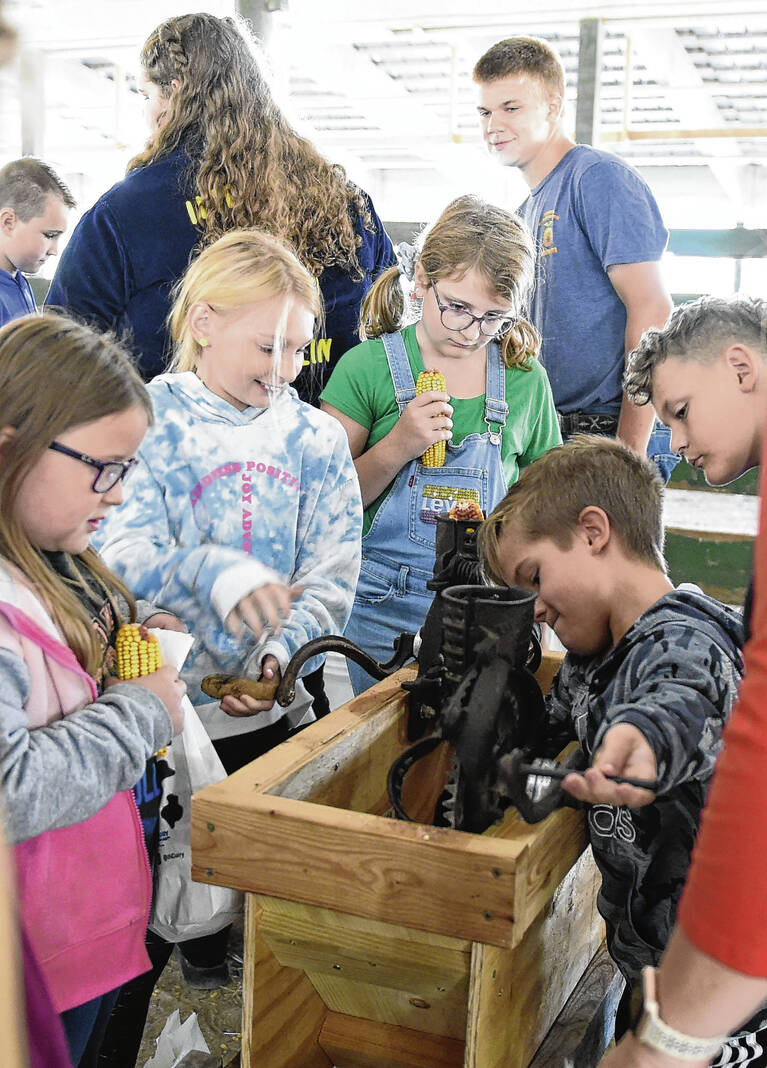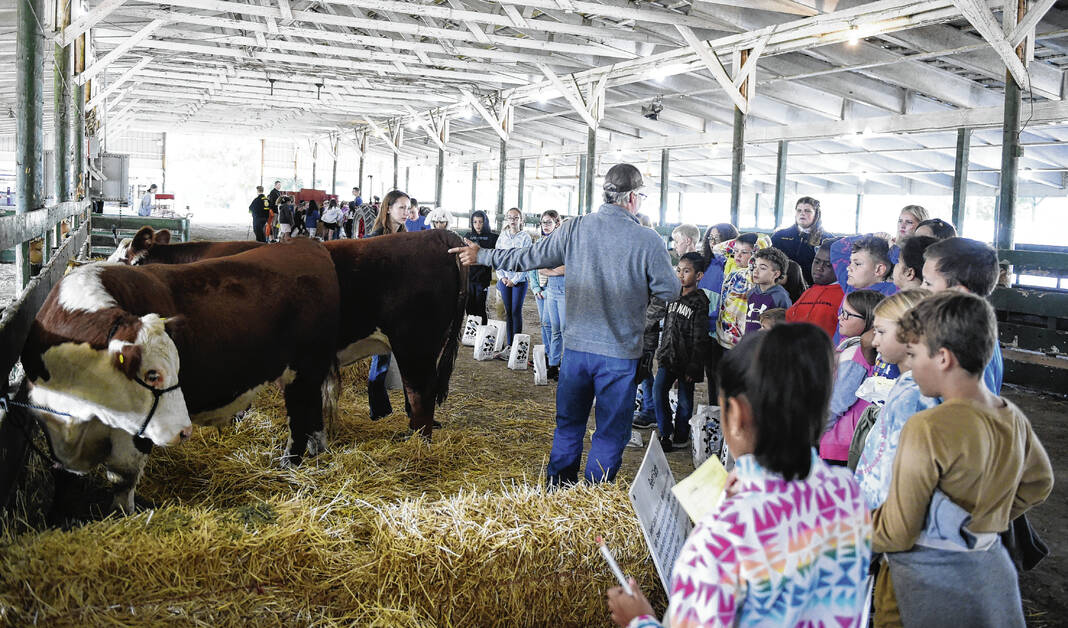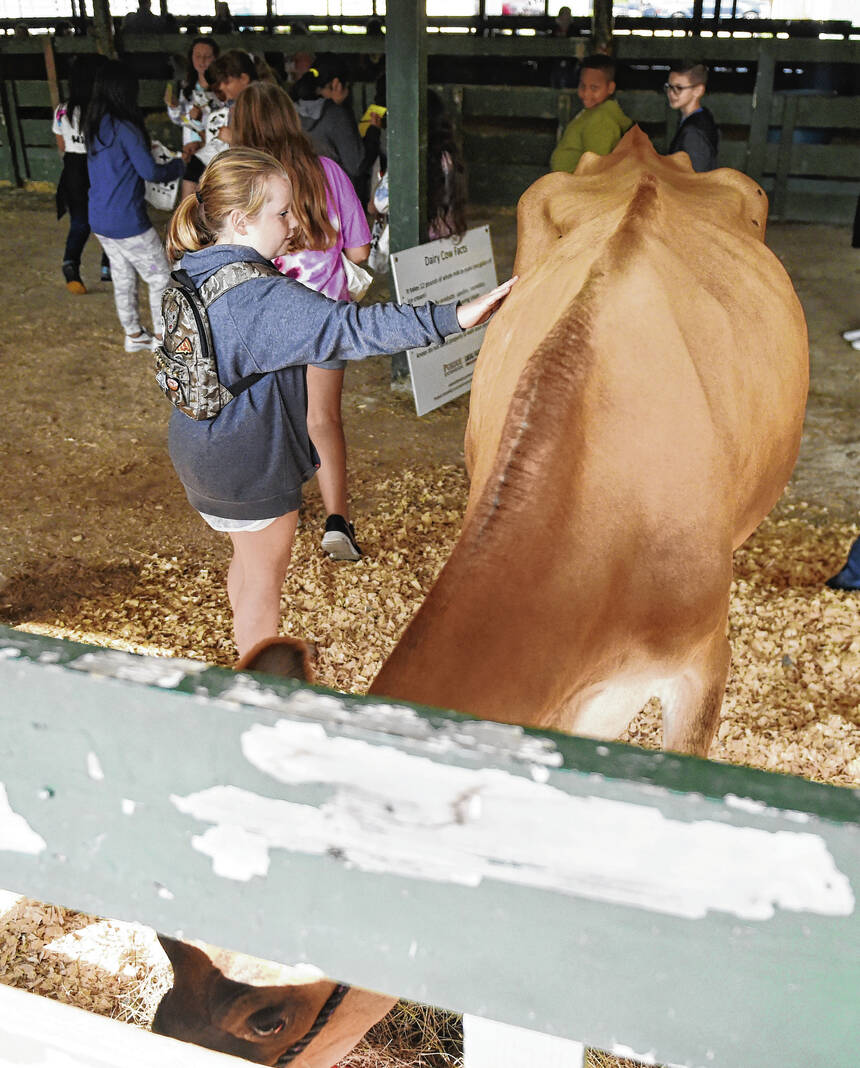A few cranks of the old-time machinery was all it took to get hands-on with Johnson County’s agricultural tradition.
Students from Northwood Elementary School stood inside the cattle barn at the county fairgrounds, listening intently to a lesson about corn production and how to shuck it. They had come out to the annual Johnson County Agriculture Days — a program of Purdue Extension Johnson County designed to teach young people about the long and abundant agricultural heritage of the area.
As their lesson drew to a close, the students had the opportunity to step up to antique corn shuckers and try it themselves.
Excited shouts filled the barn with each successful ear shucked.
More than 600 fourth-grade students came to the fairgrounds this week for Ag Days this year. Children were given quick-hit lessons about livestock such as cattle, sheep, goats and swine, in addition to grain production and fruit growing in the county.
They discovered more about the importance of soil management, and why bees are so vital to our entire way of life.
With so many people living in urban and suburban settings now, young people don’t get this exposure on a regular basis, but it’s still important information, said Cathy Morris, program assistant for Purdue Extension Johnson County.
“There are very few young people that live the rural life and are involved in farming. The importance of knowing where your food comes from should be a higher priority to be taught to our children in Johnson County,” she said. “Therefore we the Purdue Extension staff are working with community organizations and businesses as well as involving local volunteers to provide this education in a way that holds the attention of the fourth graders of Johnson County and is a fun and memorable experience.”
Ag Days is a longstanding tradition for Purdue Extension Johnson County. Working with local agriculture organizations, such as the Johnson County Farm Bureau and Johnson County Beef Cattle Association, as well as area farmers, the extension office puts together a program aimed at a wide variety of ag-related topics.
Providing information is vital as fewer people are as connected to farming and the land as they used to be, said Sarah Hanson, ag and natural resources educator and county extension director.
“You can see some of the kids come in, they know about farming, some might even live on a farm. But some of them don’t. So it’s interesting as you talk to the different groups to see who knows what,” Hanson said. “You can feel what they know, and provide a little bit of education for the group.”
Ag Days is driven by volunteers from throughout the community, who share their expertise and experience about agriculture over the course of two days.
Don Sprinkle and his wife, Christi, have been involved with Ag Days for more than 20 years. The Center Grove-area couple had been active in 4-H before then, first with their own children, then staying on as volunteer leaders in the organization.
Ag Days seemed like a good way to stay involved, Sprinkle said. He manned the microphone, announcing when it was time for the students to rotate and welcoming the groups as they arrived.
“This came up, and we were asked if we could help. They made me the announcer, since I’ve got a big mouth, it’s something I can do,” he said with a smile. “We’ve been helping ever since. This program brings these kids in and lets them know what farming is all about.”
On Tuesday and Wednesday, students from 10 schools, as well as home-schooled students, made their way to the fairgrounds. They came from Franklin, Greenwood, Indian Creek and White River Township.
Upon arrival, the children cycled through 12 stations, covering a wide variety of agricultural topics.
Students learned about the life cycles of chickens and found out that the by-products from beef are used in everything from crayons to soap.
Volunteer Becky Haveman quizzed the kids about the friends (rain, sun, honey bees) and enemies (hail, frost) of fruit orchards. A model and toy trucks helped illustrate ways farmers protect soil and water, and why it’s so important to do so.
Out in the show barns, students could pet a dairy cow, learn about the four-part stomachs of beef cattle and shuck their own corn.
“We have people who are very passionate, and they’ve always been involved, so they’ll have an established station that they’re going to teach,” Hanson said. “But we’ve had new stuff too. This we took a step back in time, with the hand-crank corn shucker and the antique tractor.”
Organizers hope that by understanding a little bit better how the food we eat reaches our tables, they’ll have an appreciation for the work that farmers do.
“We want them to know where food comes from and understand a little bit more. I talk to them about the fields they see when they’re driving around the county — you see all these fields, but do you understand what they’re growing and why they’re growing it?” Hanson said. “












